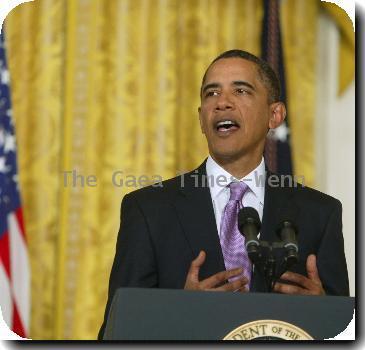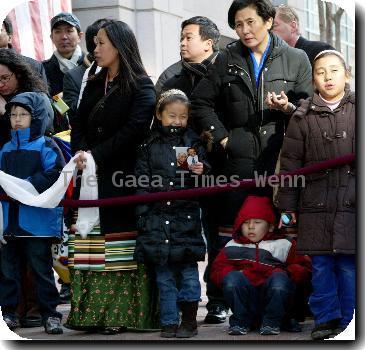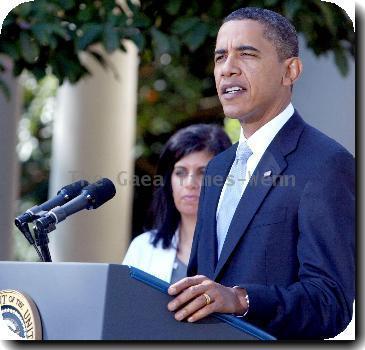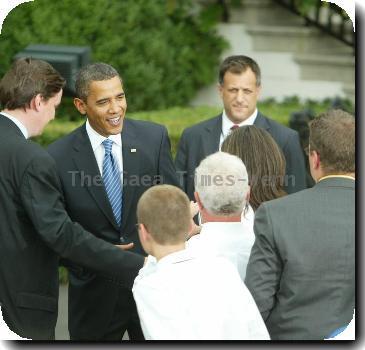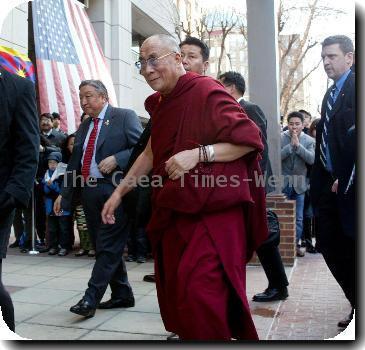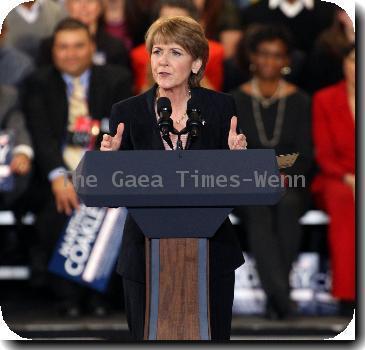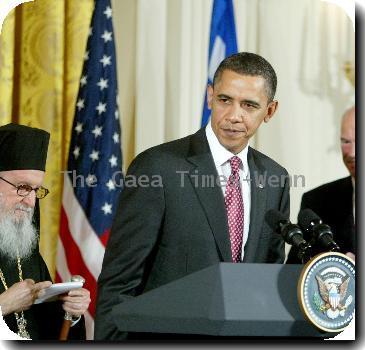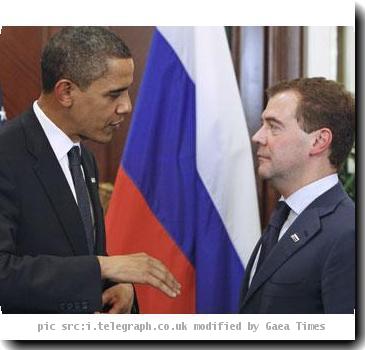Chosen by Obama, Elena Kagan would give Supreme Court three female justices for first time
By Ben Feller, APMonday, May 10, 2010
Obama taps Kagan to give court historic 3rd female
WASHINGTON — Introducing his Supreme Court nominee to the nation, President Barack Obama on Monday portrayed Elena Kagan as a guiding force for a fractured court and a champion of typical Americans. She would be the youngest justice on the court and give it three women for the first time in history.
Less excited, Republican senators said they would give the nomination a long, hard look in potentially contentious summertime confirmation hearings. One declared he would oppose her, but Democrats hold a strong majority of Senate seats, making eventual approval likely.
In choosing Kagan, the U.S. solicitor general and a former dean of Harvard Law School, Obama sought someone he hopes will seal majority votes on a divided court, as the retiring Justice John Paul Stevens sometimes had the ability to do. The president, who said Kagan has “one of the nation’s foremost legal minds,” wanted someone who could counter the court’s conservative leaders as well as sway votes with her thinking and temperament.
Obama chose a nominee who has never been a judge, a factor the White House said had worked in Kagan’s favor, giving her a different perspective from the other justices. Poised to put his imprint on the court for a second time, the president embraced Kagan’s profile: a left-leaning lawyer who has won praise from the right, earned political experience at the White House and on the college campus, cleared one Senate confirmation already and served as the nation’s top lawyer.
He wanted not just a justice who would thrive, but one who would lead.
At 50 years old and with lifetime tenure, Kagan could extend Obama’s court legacy by decades. Her vote could be the difference on cases that shape American liberties and the scope of the government’s power.
The choice also makes history for Obama, and he reveled in it. After being the first president to appoint a Hispanic justice last year in Sonia Sotomayor, he would also be the one who ensured that three women would serve on the court at the same time. Kagan would join Sotomayor and Ruth Bader Ginsburg.
Mentioning Kagan’s late mother, Obama said: “I think she would relish, as do I, the prospect of three women taking their seat on the nation’s highest court for the first time in history — a court that would be more inclusive, more representative, more reflective of us as a people than ever before.”
A beaming Kagan shared a handshake and a kiss with Obama, who towers over her, and then she stepped up on a riser to accept the honor of her life. Her comments emphasized a career built on teaching and arguing the law, not the judicial beliefs that she will be closely questioned about by senators.
She said the court allows “all Americans, regardless of their background or their beliefs, to get a fair hearing and an equal chance at justice.” That seemingly straightforward line of thinking has enormous weight with Obama, who has grown frustrated with a Supreme Court he says is tilting away from average Americans.
The White House immediately launched a political and communications campaign to define Kagan’s nomination in its terms. She is expected to start making courtesy visits on Capitol Hill this week. Obama himself started calling lawmakers of both parties on her behalf on Monday.
Because she has spent little time as a litigator and has not served as a judge, Kagan does not come with the usual trove of legal briefs or court opinions reflecting a judicial or legal style. But there are still subjects for potential Senate foes to explore.
For example, at Harvard, Kagan strongly criticized the military’s “don’t ask, don’t tell” policy regarding gay service members as discriminatory; she joined a Supreme Court case seeking to invalidate the law that put colleges at risk for losing federal money if they banned military recruiters. But the Supreme Court upheld the law unanimously.
If confirmed, Kagan would not be expected to alter the balance of power on the court. While she might vote the same way as Stevens on a range of issues and has a reputation of bridging divides, she can’t be expected immediately to fill Stevens’ role as chief emissary to the justice who often is the swing vote needed for a majority, Anthony Kennedy.
Unlike last year, when the White House emphasized Sotomayor’s compelling life story, this time the selling point is Kagan’s career path. She was a Supreme Court clerk, a law professor at the University of Chicago — along with Obama — and later a lawyer and domestic policy aide in Bill Clinton’s White House and the dean of Harvard Law.
Kagan was nominated to a federal appeals court post by Clinton but was never voted on by the Senate.
Inside the shimmering East Room of the White House, there was more a feeling of completion than drama. Kagan was a finalist for a Supreme Court opening last year and was seen as a likely choice this time, even as Obama went through a methodical review, including formal interviews of three other candidates.
One of the most notable parts of Monday’s ceremony was what Obama did not say.
There was no mention that Kagan had never served as a judge. By contrast, last year the president introduced Sotomayor, a federal judge, by trumpeting that she had more experience on the bench than any of the sitting justices had had when nominated.
“Ms. Kagan’s lack of judicial experience and short time as solicitor general, arguing just six cases before the court, is troubling,” said Sen. Jeff Sessions of Alabama, the top Republican on the Judiciary Committee, which will hold Kagan’s confirmation hearings.
Kagan was confirmed as solicitor general last year with the help of seven Republicans, but some of those same lawmakers warned that they would be starting over now. “A temporary political appointment is far different than a lifetime appointment to the Supreme Court,” said Jon Kyl of Arizona.
Democrats hold 59 votes in the Senate, more than enough to confirm Kagan, but one shy of the 60 needed to prevent a vote-blocking delay maneuver.
With midterm elections as a backdrop, both parties are likely to tangle over her qualifications and the timing of a final vote. Those debates have the potential to devolve into partisan proxy fights about the role of a Supreme Court justice and about divisive issues ranging from abortion to political speech.
Democrats are pressing for a vote by early August, and Sessions said that timetable “should be doable,” although unexpected circumstances could develop to slow it down.
Sen. James M. Inhofe, R-Okla., said flatly that he would oppose Kagan. He said she had shown “seeming contempt” for the Senate confirmation process and a “lack of impartiality when it comes to those who disagree with her position.”
If confirmed, Kagan would have to step aside from any case that passed through the solicitor general’s office during her time there. That could be a dozen to several dozen cases that actually are heard by the court, and many more that the justices dispose of without a hearing.
White House press secretary Robert Gibbs said Kagan would continue to work on cases as solicitor general but would not take on any new ones. The solicitor general represents the U.S. government and defends acts of Congress in relevant matters before the Supreme Court.
If she wins confirmation, women would make up one-third of the court. They account for more than half the U.S. population and about one in three lawyers. She would be the third Jewish justice along with six Catholics. With Stevens’ retirement, the court would have no Protestants, the most prevalent denomination in the United States.
Kagan, who is unmarried, was born in New York City and holds degrees from Princeton, Oxford and Harvard.
She would succeed Stevens, who became a leader of the court’s liberals. He will soon leave the court at age 90 after nearly 35 years. Obama called Stevens a giant in the law and then passed the responsibility onto his friend Kagan to “ultimately provide the same kind of leadership.”
Associated Press writers Mark Sherman, Matt Apuzzo, Julie Hirschfeld Davis, Julie Pace, Darlene Superville, Natasha T. Metzler, Tom Raum and David Espo contributed to this story.
Tags: Barack Obama, Bill Clinton, District Of Columbia, Elena kagan, Higher Education, Judicial Appointments And Nominations, Legislature Hearings, Military Affairs, North America, United States, Washington


